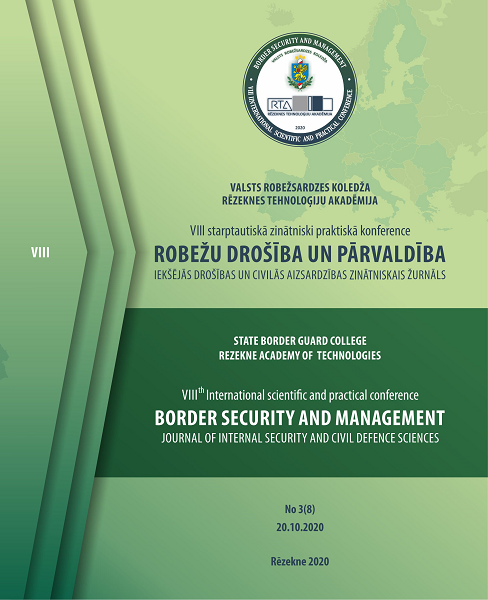INTELLIGENCE CYCLE AS PART OF EFFECTIVE RISK ANALYSIS UNDER INTEGRATED BORDER MANAGEMENT
DOI:
https://doi.org/10.17770/bsm.v3i8.5356Keywords:
data management, information, intelligent cycle, risk analysis, sourcesAbstract
The aim is to present common approach of processing of information as one of the main aspects for qualitative risk analysis, including all three components – threat, vulnerability and impact, in all levels: strategic, operational and tactical. The theoretical methodology is based on guidelines of common integrated risk analysis model (CIRAM), implemented in Schengen member states (MS) as a part of integrated border management (IBM). Based on the main task – to view particular legal bases and using historical research, analytical and descriptive methods, the legal bases of IBM in the field of risk analysis was explained, at first. Special attention was paid for description of each step of intelligent cycle, because only scrupulous following of methodology guaranteed the high quality of the product in situations when analytical units have huge amount of data from different sources every day. Different kinds of risk analysis (annual, quarterly, monthly, weekly or targeted for specific measures) are performed by European Border and Coast Guard (EBCG) and MS using the CIRAM methodology. Huge data flows should be managed in a structured way. The knowledge and practical implementation of CIRAM has a positive impact on overall internal security in the area of free movement. For this purpose, the amount of trained border guards was analysed.
References
European Border and Coast Guard (2019) Consolidated Annual Activity Report Nr.5865. Retrieved July 11, 2020, from https://www.europarl.europa.eu/cmsdata/185405/CAAR%202018.pdf
European Border and Coast Guard (2019). Information Management. Retrieved July 11, 2020, https://frontex.europa.eu/intelligence/information-management/
EUROPEAN COMMISSION (2017). European Integrated Border Management Strategy. Meeting of the Expert Group "Management of the External Borders". Retrieved July 11, 2020, from https://ec.europa.eu/transparency/regexpert/index.cfm?do=groupDetail.groupDetailDoc&id=33415&no=7
FRONTEX (2012). Common integrated risk analysis model guidelines, v.2.0;
Regulation (EU) 2016/399 of the European Parliament and of the Council of 9 March 2016 on a Union Code on the rules governing the movement of persons across borders (Schengen Borders Code). 23.03.2016. Official Journal L, 2016, no. 77/1.
Regulation (EU) 2019/1896 of the European Parliament and of the Council of 13 November 2019 on the European Border and Coast Guard and repealing Regulations (EU) No 1052/2013 and (EU) 2016/1624. 14.11.2019. Official Journal L, 2019, no. 295/1.






